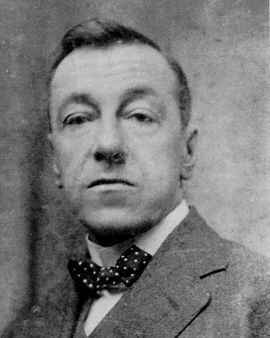Harold Copping (1863-1932) was an English artist from London, also known as an illustrator. In addition to his talent, he enjoyed a university education at the Royal Academy of Arts. His artistic work consisted primarily of illustrations of biblical scenes and motifs from the novels of Charles Dickens. Besides well-known novels by Dickens such as Oliver Twist, David Copperfield or A Christmas Carol, which belong to the Victorian literature, he illustrated other literary works, such as John Bunyan's The Pilgrims Progress.
As a member, his artistic work was influenced by the London Missionary Society as well as the Religious Tract Society (RTS), for which he created twelve pictures a year with a religious theme. The Bible and Jesus were among his greatest sources of inspiration. His pictures are characterized above all by authentic features that are close to reality. In order to get a picture of himself, Copping went on study trips to Egypt and Palestine. Just as Dickens authentically fictionalized the social discrepancies of Victorian society in the age of industrialization in his novels, Copping's aim was to make his illustrations realistic. But it was not only religion, travel and reality that inspired him. His methods also included using people from his family and circle of friends as models for his works. Especially for this purpose he was equipped at home with appropriate costumes and props. Many of his works depict a variety of people.
Most of Copping's illustrations were circulated as color lithographs. Among his most famous works of art is The Hope of the World (1915), which depicts Jesus surrounded by children from all over the world. In 1910, Copping illustrated a special edition of the Bible, known as The Copping Bible, which underlined his religious motivation. He also created illustrations for magazines such as Pearsons Magazine and The Royal Magazine. His Canadian Pictures, created with watercolours as a result of his trip to Canada, are also worth mentioning and show his motives for depicting reality.
×





_-_(MeisterDrucke-1496636).jpg)
_-_(MeisterDrucke-1496636).jpg)
.jpg)
.jpg)
.jpg)
.jpg)
.jpg)
.jpg)
.jpg)
.jpg)
.jpg)
.jpg)
.jpg)
.jpg)
.jpg)
.jpg)
.jpg)
.jpg)
.jpg)
.jpg)
_-_(MeisterDrucke-1502065).jpg)
_-_(MeisterDrucke-1502065).jpg)
_-_(MeisterDrucke-1319519).jpg)
_-_(MeisterDrucke-1319519).jpg)
.jpg)
.jpg)
.jpg)
.jpg)
.jpg)
.jpg)
.jpg)
.jpg)
.jpg)
.jpg)
.jpg)
.jpg)
.jpg)
.jpg)
.jpg)
.jpg)
.jpg)
.jpg)
.jpg)
.jpg)
.jpg)
.jpg)
.jpg)
.jpg)
.jpg)
.jpg)
_-_(MeisterDrucke-1496400).jpg)
_-_(MeisterDrucke-1496400).jpg)
.jpg)
.jpg)
.jpg)
.jpg)
.jpg)
.jpg)
.jpg)
.jpg)
.jpg)
.jpg)
.jpg)
.jpg)
.jpg)
.jpg)
.jpg)
.jpg)
.jpg)
.jpg)
.jpg)
.jpg)
.jpg)
.jpg)
.jpg)
.jpg)
.jpg)
.jpg)
.jpg)
.jpg)
.jpg)
.jpg)
.jpg)
.jpg)
.jpg)
.jpg)
.jpg)
.jpg)
.jpg)
.jpg)
_-_(MeisterDrucke-1063222).jpg)
_-_(MeisterDrucke-1063222).jpg)
.jpg)
.jpg)
.jpg)
.jpg)
.jpg)
.jpg)
.jpg)
.jpg)
.jpg)
.jpg)
.jpg)
.jpg)
.jpg)
.jpg)
.jpg)
.jpg)
.jpg)
.jpg)
.jpg)
.jpg)
.jpg)
.jpg)
.jpg)
.jpg)
_-_(MeisterDrucke-1485497).jpg)
_-_(MeisterDrucke-1485497).jpg)
.jpg)
.jpg)
.jpg)
.jpg)
.jpg)
.jpg)
.jpg)
.jpg)
.jpg)
.jpg)
.jpg)
.jpg)
.jpg)
.jpg)
_-_(MeisterDrucke-1503477).jpg)
_-_(MeisterDrucke-1503477).jpg)
.jpg)
.jpg)
.jpg)
.jpg)
_-_(MeisterDrucke-1485509).jpg)
_-_(MeisterDrucke-1485509).jpg)
.jpg)
.jpg)
.jpg)
.jpg)
.jpg)
.jpg)
.jpg)
.jpg)
.jpg)
.jpg)
.jpg)
.jpg)
_-_(MeisterDrucke-1494502).jpg)
_-_(MeisterDrucke-1494502).jpg)
_-_(MeisterDrucke-1502226).jpg)
_-_(MeisterDrucke-1502226).jpg)
_-_(MeisterDrucke-1063232).jpg)
_-_(MeisterDrucke-1063232).jpg)
_-_(MeisterDrucke-1485510).jpg)
_-_(MeisterDrucke-1485510).jpg)
.jpg)
.jpg)
.jpg)
.jpg)
_-_(MeisterDrucke-1064117).jpg)
_-_(MeisterDrucke-1064117).jpg)
_-_(MeisterDrucke-311386).jpg)
_-_(MeisterDrucke-311386).jpg)
.jpg)
.jpg)
.jpg)
.jpg)
.jpg)
.jpg)
.jpg)
.jpg)
.jpg)
.jpg)
.jpg)
.jpg)
.jpg)
.jpg)
.jpg)
.jpg)
.jpg)
.jpg)
.jpg)
.jpg)
.jpg)
.jpg)
.jpg)
.jpg)
_-_(MeisterDrucke-1496409).jpg)
_-_(MeisterDrucke-1496409).jpg)
.jpg)
.jpg)
.jpg)
.jpg)
.jpg)
.jpg)






